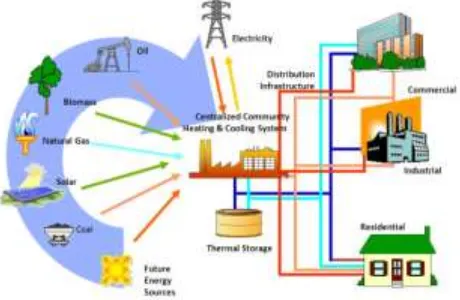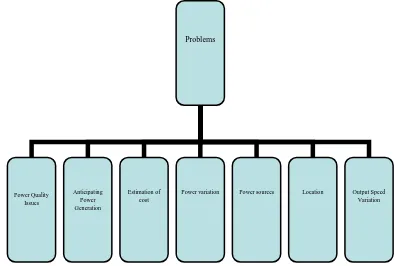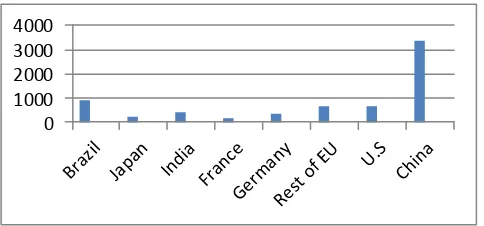© 2018, IRJET | Impact Factor value: 6.171 | ISO 9001:2008 Certified Journal | Page 2563
Integration of Renewable Energy Technologies in AC Power System
Grid
K. Vidyavathi
1, N. Divya
2, M. Dhana Lakshmi
31,2,3
Department of Electrical and Electronics Engineering, Selvam College of Technology, Namakkal
---***---ABSTRACT
: Today, renewable energy has been becomingone of the independent energysources in human life, and it will be important resources for the future generation of power. In recent days, some people tend to use renewable energy in their home, land, small scale industries such as solar or wind energy. Most of those have two inputs of the power source; the utility power supply and renewable energy power supply, so the integration of renewable technologies like solar, wind generation sources within AC grid has been made, but this connection is more complicated to reach. This paper will be reviewed the Problems and advantages of integrating renewable energy into power system grid. A review of the integration process will be introduced. Also, the paper will discuss some power quality requirements that must be achieved to get this connection successfully. Anticipating of renewable energy such availability of the location of RE source, power at any time, the amount of variation in power output and the speed of variation are other problems that may obstruct the successful incorporation of renewable energy and the grid problems. In addition, this paper will briefly show a device that can be used in homes to achieve this connection. Finally, advantages of the integration for both the power utility and the green energy owner will be present, and we can get awareness of how this integration can affect our environment.
Keywords:
Renewable energy RE, grid, green energy,integration, global warming
I. INTRODUCTION
Due to the emission of burring gas and other fossil fuels in order to produce energy global warming has influenced the earth. The emission could affect our health, water, weather, animals, and as well as our plants and forests. Most of power generation plants in the world use burning fossil fuels such as petroleum, natural gas, or coals, and this result in many productions of negative emissions such as dioxide carbon. So, this output of emission affects the earth’s atmosphere.
According to U.S. Energy Information Administration, the total carbon dioxide emission in the United States is 5,271 million metric tons in 2015, and 1,925 million metric tons is just from producing the electrical power “Electricity”.
However, our awareness of the risk of climate changing and global warming leads us to find alternative resources for the generation of electricity. So, power generation technologies have developed several solutions
of how we can produce neat, compact, economic, and safe energy.
As a result, in the recent years, renewable energy technologies have been rapidly improved in high performance, and they are possible way to face the risk of the gas emission. RE, or as named green energy, spared widely around the world, and the science of RE has been improved in generating high amount of watts. Among these resources, solar and wind energy produce around 217.4 million kilowatts per hour in 2015 as the next generation of electricity in the U.S., according to U.S Energy Information Administration. Power generation from RE sources contains various technologies such as solar energy, biomass energy, wind energy, nuclear energy, geothermal energy, ocean energy and tidal energy. Term of “integration” has been used for the relationship between “renewable electricity supplies” and “power AC grid”.
[image:1.595.319.549.540.690.2]In the recent decades, the incorporating RE into the AC grid is developed and used in which way of high quality and reliability, so the power grid can get watts “power” from many types of RE. In 2012, renewable electricity shares around 21% of the world annual electricity generation, according to U.S. IEA. However, this integration is challenging, especially in the large scale of the system, and it has many issues and difficulties that should be achieved in the right way to have the desired connection. On other side, there are many positive aspects when the renewable energy and the AC grid have been integrated.
© 2018, IRJET | Impact Factor value: 6.171 | ISO 9001:2008 Certified Journal | Page 2564
II. INTEGRATED RE
The integrated RE is the process of power transfer “watt” from renewable energy sources to the utility system grid, so the network is fed by a source of RE. Figure.1 describes in general the shape of the integration of RE technologies into the grid. The AC grid could have two input of power generation: conventional/ unconventional power plants and RE plants “wind, solar, etc.”
The output of power from RE has to be an AC power in order to meet integration conditions where allow power to transfer to the substation A, which might be a distribution substation. After that, the power can move to transmission lines, which could be high or low voltage, or directly to distribution system, which usually is low or medium voltage.
III. PROBLEMS TO BE FACED
Most of green energy sources rely on uncontrolled recourses. On other words, producing power from RE comes from nature resources such as sunshine, wind, or ocean waves. This kind of sources leads us to know that power generation from RE is intermittent and inconstant.
[image:2.595.309.563.428.577.2]As a result, it is a challenge mission to share power from RE technologies into Ac grid. There are many problems of this incorporation and figure 2 shows the mainly issues that will be discussed as follow: power quality, cost, availability of power, location of RE resource, change in power, speed of change in power, and power forecast.
Figure 2: The problems of RE-Grid integration
3.1 Issues in Power Quality
Power quality is an important major in power system to ensure stability and high efficiency of the grid system, so ideal PQ leads the system to work well with high reliability and less cost. In contrast, poor PQ can have major harmful effects on the power grid as well as industrial processes, high cost, and equipments failure. Many studies say that power quality troubles cost U.S. around $15 billion per year, according to Schneider.
Electric. PQ problems include frequency disorder, voltage/current harmonics, low power factor, voltage fluctuation and transmission lines transits. Since the power output from RE technologies are fluctuation, most of PQ issues are present either it is on-grid or off-grid. Therefore, when the integrating is designed, these concerns are going to affect the grid badly. For example, if power factor of the system goes very low, equipments will get damage. In addition, in solar energy, voltage and frequency are not constant due to amount of irradiance, so this cause voltage deviation and frequency deviation, and these two deviations are major challenges in the integrating RE into the grid.
3.2 Power Sources
One of the biggest concerns in RE-Grid integration is the power generation depends on natural resources that are uncontrollable by human. In PV energy, as shown in figure 5, producing electricity stand up on when sunshine is available and off at night, and also wind energy depends on the availability of wind, so if the speed of wind is zero or very low, the turbine will not turn, and this result in zero power flow to the grid. The instability of producing energy in RE technologies is making the integration more complex, and it causes detrimental aspects for system operation such as harmonics in the converters unless solutions has found such as storage systems such as batteries that allow to have constant frequency and voltage.
Figure 3: General structure of PV energy.
3.3 Power Generation Variation
In addition, different level of generating power from RE technologies is another difficulty of RE-Grid integration. Small vacillation in power output is not going to have a concern effect, but when the magnitude of fluctuations in power output is large, special requirements have to be considerable. In 2005, the change of MW in wind output in the E.ON Netz grid in Germany is shown in figure 4. We see that the variation between high and low peaks is 4,340 MW, and this is a large change. Also, smeller issue for solar energy that the producing power at noon is not the same at the beginning or at the end of the day.
Problems
Power Quality Issues
Anticipating Power Generation
Estimation of cost
[image:2.595.75.272.472.605.2]© 2018, IRJET | Impact Factor value: 6.171 | ISO 9001:2008 Certified Journal | Page 2565 Figure 4: Fluctuations in wind power in E.ON Netz in
Gremany [1].
3.4 Speed Variation
From figure 4, we can easily notice that the fluctuations are changing in a small period of time. The minimum power around 450 MW is changing to 4,450 MW in just 24 hours. Therefore, the fluctuation speed could appear in hour-to-hour, minutes to minutes, or even second to seconds. In slow change, power output may be expected, but on other hand, high speed of variations is another challenge that might face the RE-Grid integration in the large scale, especially.
3.5 Anticipating
Generally, Forecasting in power systems is a major subject of power management system for grid system planning to ensure the stability and high reliability. Because most of RE technologies depend on weather and environmental factors, the prediction in power generation is hard in term of accuracy. Accuracy is usually obtained in case of load forecast in power system distribution, and it results in high quality of operation due to the constant producing of power and it is to ensure the future load demand. In RE technologies, forecasting studies are required in power generation, and if the main source of power is not constant and uncontrollable, RE-Grid integration become more difficult.
In addition, each technology of RE has its own characteristics, so forecast studies and research will be different. Furthermore, there are several forecast methods for each of the technologies such as short and long term forecasts. The short term, usually in hours, is not considering problematic in the integration, but the long term is an issue due to its less accuracy and this cloud affect the operation of the grid.
3.6 Location of RE Plants
Most of RE plants that share their energy with the grid are large scale of capacity, so usually the area of such one plant is considerable. Sometimes, we are forced of the RE sources locations due to several factors that each technology has own reasons of choosing the location.
Picking a place to operate one of RE technology involves on many elements that make RE-Grid integration under challenges. First, some RE source are not available in each region. Second, distance between RE source and the grid is a major aspect in term of cost and efficiency. Also, RE sources depend on weather, climate, and geographical location.
For example, solar energy in state of Arizona or Texas is more efficient than in Michigan due to the high percent of sun radiation time per day in Arizona and Texas. As a result, the integration will be more flexible in these states than Michigan. Also, tidal and ocean wave energy are another example that points selecting location of RE and integrating into AC grid is uncontrolled.
3.7 Estimation Cost
Economic estimation is a prime part in RE_Grid integration planning since we have to keep the rate of cost low as possible. The two main aims of the RE incorporation are to save our environment and reduce the cost of generation power in both RE and conventional plants.
We can properly observe that facing these difficulties will result in some economic issue. Power generation forecast requires numerous prediction studies and simulations, and this depends on the accuracy of power generation. Also, location play a role in the total cost since most of large RE plants are located far away from cities and substations of the grid, so they require transfer power by extension transmission lines that depend on voltage level. Therefore, energy storage strategy is a solution of variation, and availability power especially in large capacity of RE plants requires massive storage system to storage energy before integrating process. However, the storage system has high cost, and it is really a challenge in term of producing high of megawatt.
IV.ADVANTAGES
Impact of RE-Grid integration has been approved, so the positive aspect of RE_Grid integration can be classified mainly as follow: environmental, social, and economic positives. First, RE technologies has zero fossil fuel emission, so the integration will help fossil fuel power generation plants to reduce emission of CO2 in way of less
© 2018, IRJET | Impact Factor value: 6.171 | ISO 9001:2008 Certified Journal | Page 2566 Figure 5: General integrating process using GRI.
Second, our societies and plant will become more clean and health due to the low reducing CO2. Also, the
integration improves the reliability of power grid failure since it uses storage system. On other words, recently, we see many people who insulate their own energy source such as solar energy, so they gain many benefits such sale the extra energy to the utility, and they have their own electricity, so if the grid fails in power, they can use their independent source. Figure 5 shows the main picture of using solar energy using grid tie inverter GTI to integrate into the grid in homes. According to Union of Concerned Scientists, there were 400,000 houses in the U.S. that used solar panels in 2013 and by 2020 will be between 900,000 to 3.8 million houses using solar energy.
Third, integrated RE improves the situation of our economic in different ways such creating new jobs. In 2014, the total universal jobs from RE technologies employment are 7.7 million jobs. In Brazil, 934,000 jobs were offered and 724,000 jobs in the U.S. in 2014 [12]. Figure 6 describes the numbers of jobs in certain countries In addition, our societies and people will become more clean and health due to the low reducing CO2.
0 1000 2000 3000 4000
Figure 6: Numbersof RE jobs “thousands” by country in 2014[12].
V.INCORPORATION FUTURE
Several studies and research on RE-Grid integration has been working to enhance and achieve more stability and efficiency of the connection. A study from International Renewable Energy Agency has drawn a plan
that is called “Remap 2030” and its aim to clear and include all data of RE in the future which it will help the integration.
According to U.S. EIA, RE technologies shared 22% of total world electricity in 2012 and it will be expected to raise the integration to 29% in 2030. The total world generation from wind energy expects to share in 2.45 trillion Kwh in 2040
Integration of various RE Technologies is one of the solutions of the mentioned problems since integrating has more advance monitoring and control of any change in power level.
VI.CONCLUSION
Increase in the integrations of RE sources to the system grid is due to the impacts of CO2 emission and global
warming result in wildly speared of renewable energy technologies in the recent years. The incorporation has been facing some difficulties to achieve the connection in the correct form. This paper has discussed the most challenges as: power quality issues, availability, variation, and speed of power, generation anticipate, and RE plants’ location.
Speaking in the benefits of RE, the positive impacts of RE-Grid integration were presents. Clear environment and health people, enhancing economic aspect in such increase availability of jobs, and helping societies in case of power’s outages are benefits of RE-Gird integration.
REFERENCE
[1]. Boyle, Godfrey. Renewable Electricity and the Grid: The Challenge of Variability. London: Earthscan, 2007. Print.
[2]. Irena. "ETSAP." Renewable Energy Integration in Power Grids (n.d.): 1-36. International Renewable Energy Agency. Apr. 2015. Web.
[3]. Keyhani, Ali. Design of Smart Power Grid Renewable Energy Systems. Hoboken, NJ: Wiley, 2011. 2011. Web.
[4]. Jahdi, Saeed, and Loi Lei. Grid Integration of Wind-solar Hybrid Renewables Using AC/DC Converters as DG Power Sources (2011): 1-7. IEEE, 2011. Web.
[5]. Anees, Ahmed. Grid Integration of Renewable Energy Sources: Challenges, Issues and Possible Solutions (2012): 1-6. IEEE, 2012. Web.
[image:4.595.42.284.546.659.2]© 2018, IRJET | Impact Factor value: 6.171 | ISO 9001:2008 Certified Journal | Page 2567 Distribution Grid (2012): 1-4. CIRED, 29 May 2012.
Web.
[7]. IEC. Grid Integration of Large-capacity Renewable Energy Sources and Use of Large-capacity Electrical Energy Storage. Geneva: IEC, 2012. IEC, 2012. Web.
[8]. Bird, L., M. Milligan, and D. Lew. "Integrating Variable Renewable Energy: Challenges and Solutions." (2013): 1-14. National Renewable Energy Laboratory. NREL, Sept. 2013. Web.
[9]. Fridley, David Fridley. "Nine Challenges of Alternative Energy." The Post Carbon Reader Series:(n.d.): 2-15. Post Carbon Institute, 2010. Web.
[10]. Frankl, Paolo. "World Renewable Energy Outlook 2030-2050." (n.d.): 1-13. International Energy Agency, Oct. 2013. Web.
[11]. Lenzi, Vasco, Andreas Ulbig, and Goran Andersson. "Impacts of Forecast Accuracy on Grid Integration of Renewable Energy Sources." 2013 IEEE Grenoble Conference (2013): n. pag. IEEE, 2013. Web.
[12]. "Western Wind and Solar Integration Study: Executive Summary." (2010): 1-40. GE Energy, 2010. Web.
[13]. IRENA. "Renewable Energy and Jobs Annual Review 2014." (2014): 1-12.IRENA. May 2104. Web.
[14]. EIA. International Energy Outlook 2016. Rep. EIA, 2016. Web


![Figure 4: Fluctuations in wind power in E.ON Netz in Gremany [1].](https://thumb-us.123doks.com/thumbv2/123dok_us/8130948.796891/3.595.37.292.74.221/figure-fluctuations-wind-power-e-netz-gremany.webp)
